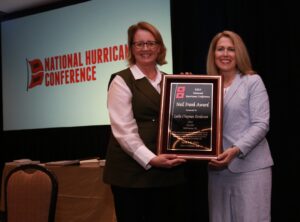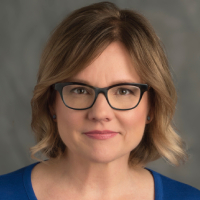
Leslie Chapman-Henderson Honored with NHC’s 2023 Neil Frank Award
Chapman-Henderson is the first woman to receive the Neil Frank Award, which is the NHC’s highest honor
The National Hurricane Conference (NHC) is the nation’s premier conference for hurricane preparedness, response, recovery and mitigation training and education. NHC serves as a national forum for federal, state and local officials to exchange ideas and recommend new policies to improve emergency management.
During the 2023 National Hurricane Conference (NHC) in New Orleans, the prestigious Neil Frank Award was presented to Leslie Chapman-Henderson, President and CEO of the nonprofit Federal Alliance for Safe Homes (FLASH).
Chapman-Henderson is the first woman to receive this award, which is the NHC’s highest honor. She was chosen for her exceptional work on improving hurricane preparedness. “Leslie has been a national leader in achieving resilience by preparing for the impacts of tropical cyclones since the devastation of Hurricane Andrew in 1992,” said Bill Read, Former NHC Director and Awards Committee member. “Advances in building codes have been outstanding largely due to her leadership through FLASH.”

The Neil Frank Award was named after the atmospheric scientist who was the National Hurricane Center Director from 1974-87 and was instrumental in advancing both the scientific and informational aspects of hurricane forecasting.
Federal Alliance for Safe Homes Founded to Better Address Disaster Relief
FLASH is the country’s leading consumer advocate for strengthening homes and safeguarding families from disasters. The organization strives to promote life safety, property protection and resiliency by empowering the community with knowledge and resources.
Over 100 diverse organizations comprise FLASH’s diverse membership, including:
- The International Code Council
- FEMA
- The National Weather Service
- Simpson Strong-Tie Co.
- State Farm
- The Weather Channel
- MyRadar
Chapman-Henderson Becomes First FLASH Employee
In 1992, Hurricane Andrew struck an unprepared South Florida, causing devastating property damage, injuries and deaths. This disaster revealed weaknesses in critical community functions and inspired more modern disaster preparedness.
Aspects such as improved emergency management communications, utility provisions, insurance response and weather forecasting technology were reconsidered and led to the creation of the FLASH.
“After seeing the damage firsthand from Hurricane Andrew, I wanted to help,” Chapman-Henderson said. “I was part of the hurricane’s insurance response team and witnessed the disruption and loss that thousands of families suffered when they lost their homes. I wanted to learn the science behind why some homes sustained more damage than others.”
The Insurance Institute for Business and Home Safety formed the pilot project that established FLASH. That partnership pursued two mission goals: first, new homes must be built correctly using modern codes; and second, existing structures must be retrofitted to bring them up to standard.
After over a decade in the insurance industry, Chapman-Henderson joined FLASH as its first employee.
“We had to rethink how to build our homes in the face of hurricanes,” Chapman-Henderson said. “Today, we advocate for building codes with standards derived from advanced engineering research, as well as more consistent code enforcement. Building codes are the foundation of resilience.”
FLASH Advocates Preparedness Education with Industry, Government and Media Partners
As FLASH’s President and CEO, Chapman-Henderson forges and sustains partnerships and advocates for key state and federal policy initiatives. She also leads creative development processes for design tools and programs to help deliver messages to the public. These have included a 4D experience at Disney’s EPCOT called StormStruck: A Tale of Two Homes, and an award-winning 2016 campaign called “#HurricaneStrong.”
Most recently, she launched “No Code. No Confidence. InspectToProtect.org,” a research-informed public education campaign about the importance of modern building code adoption.
InspectToProtect.org helps citizens understand disaster risks in their location and provides retrofit suggestions to help strengthen their properties. The program is also “a call to arms for our partners to drive codes forward,” she said.
Chapman-Henderson also coordinated the landmark National Earthquake Conference, which secured $10 million for the Earthquake Early Warning research effort, along with the White House National Initiative to Modernize Building Codes, plus improve climate resilience and reduce energy costs.
National Disaster Resilience Spokesperson
Chapman-Henderson regularly appears on regional and national news outlets as a subject matter expert, and she co-produced the PBS special Blueprint for Safety: Disaster-Resistant Homes.
She also delivers industry keynote addresses around the world, including at the United Nations, and publishes blogs and commentary papers on the topic.
“We want model codes to reflect the best research and engineering to ensure that residential construction stands up to disasters as billion-dollar events accelerate,” said Chapman-Henderson. “We want every state to adopt and enforce modern model codes. Plus, we want disaster-exposed states to establish programs to help families with older homes retrofit to make them stronger and more resilient.”

Educating the Public About Disaster Preparation Building Codes
Chapman-Henderson is surprised when individuals, leaders and professionals oppose current model building codes and only come to realize the benefits after a catastrophe occurs. By then, communities are overwhelmed by years or decades of difficult and expensive recoveries.
“The avoidable deaths, injuries, accelerating losses, insurance challenges caused by those losses, and general diminution of quality of life, should create universal motivation to endorse local codes before disasters,” she said.
FEMA notes that about one-third of U.S. jurisdictions lack optimal building performance regulations for hurricanes, tornadoes, floods, earthquakes and wildfires. Many local and state governments adopt weaker model codes or ignore the safety mandates.
Chapman-Henderson noticed that most people don’t think about codes until, and unless, groups like FLASH make the connection for them.
“Yet we have made tremendous progress in the realm of public awareness and everyday acceptance of building codes and resilience,” she said. “We have gained many new and diverse allies with elected officials, weather professionals, news media and civic-minded corporate supporters.”
Building Code Collaboration, Lifelong Learning and Listening Drive an Impactful Career
To achieve such strides over the last 30 years, Chapman-Henderson credits her many mentors for helping her succeed, and notes that “when we win, we win together.”
She’s also a lifelong learner, saying that “we germinate our best ideas by staying curious and open to new thinking.” She knows that her responsibility is to communicate generously and continuously to every relevant audience that is willing to listen. “You never know where your greatest breakthrough opportunity or new partnership may come from, so you must recognize and act on serendipity when it happens,” she said.
As the 2023 hurricane season begins, generally June 1 through November 30 (but changing and accelerating due to the climate crisis), Chapman-Henderson remains ready and optimistic.
“Preventing deaths and injuries, plus helping preserve people’s quality of life in the face of disaster, is my greatest motivator,” she said. “It is possible to achieve our resilience goals because we know to build to withstand damage.”
“Learning the stories of families who survive disasters inspires me to stay on track and never give up,” Leslie Chapman-Henderson added. “That, as well as forging lifelong friendships with so many dedicated leaders across disciplines is one of my greatest job benefits.”
To learn more about FLASH and to learn how to be prepared for a disaster in your area, click here.








